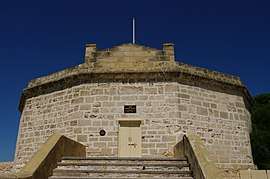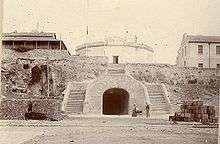Round House (Western Australia)
The Round House was the first permanent building built in the Swan River Colony. Built in late 1830 and opened in 1831, it is the oldest building still standing in Western Australia.[1]
| Round House | |
|---|---|
 The Round House from the east | |
%26groups%3D_0047705da2f52fd48c52434a1875defe9cf54f63.svg)
| |
| General information | |
| Type | Prison |
| Architectural style | Panopticon |
| Address | Arthur Head |
| Town or city | Fremantle, Western Australia |
| Country | Australia |
| Coordinates | 32°3′22″S 115°44′29″E |
| Construction started | August 1830 |
| Completed | 18 January 1831 |
| Cost | £1603/10/0 |
| Owner | City of Fremantle |
| Technical details | |
| Floor count | 2 |
| Design and construction | |
| Architect | Henry Willey Reveley |
| Main contractor | Richard Lewis, W Manning and I Duffield |
| Other information | |
| Number of rooms | 8 cells + other rooms |
| Website | |
| Fremantle Roundhouse | |
| Type | State Registered Place |
| Designated | 13 November 1993 |
| Reference no. | 896 |
It is located at Arthur Head in Fremantle, and recent heritage assessments and appraisals of the precinct of the Round House incorporate Arthur Head.[1]
Design and construction

It was designed by Henry Willey Reveley; construction commenced in 1830 and was completed on 18 January 1831.[1][2] Intended as a prison, it had eight cells and a jailer's residence, all of which opened onto a central courtyard. The design was based on the Panopticon, a kind of prison designed by philosopher Jeremy Bentham.[3]
The Round House was built by Richard Lewis in partnership with W Manning and J H Duffield for £1840/0/0. Worked commenced in August 1830 and was complete in January 1831 for the cost of £1603/10/0 this lower cost was due to the builders' being able to source the limestone locally. In 1833 a well was dug in the central compound. Reveley calculated that the depth of the well needed to be 14 metres (45 ft). The Fremantle Whaling Company in 1837 requested that a tunnel be dug through Arthur Head to High street. As part of the agreement they constructed a breakwater to protect shipping up to 150 tons. The company paid for both the construction of the tunnel and the breakwater with Reverley overseeing both.[1]
The tunnel was 57 metres long and linked the Bathers Beach Whaling Station to the High Street. The tunnel was constructed in five months and completed in January 1838. This rapid progress was possible because prisoners from the Round House were used and the rock, although load bearing and sound, was capable of being mined with a pick axe. Today the tunnel is only 45 metres long, as the cliffs were cut back some time after 1880.[4]
Usage
The Round House was used for colonial and indigenous prisoners until 1886, when control of the Convict Establishment prison (now Fremantle Prison) was transferred to the colony. After that the Round House was used as a police lockup until 1900, when it became the living quarters for the chief constable and his family.[5]
As early as 1903 its removal had been suggested;[6] again in 1929 unsuccessful suggestions were made to remove the Round House.[7][8]
In 1936 it was vested in the Fremantle Harbour Trust for preservation. A number of suggestions were put forth, including turning it into a museum,[9] but these plans were interrupted by World War II.
In 1966 the Port Authority opened the building to the public for two hours per day. Later, this attraction was run by the Western Australian Historical Society. The building was transferred to the City of Fremantle in 1982 and has been open daily since then.
Prisoners
Executions
The first person of European descent to be executed in Western Australia was 15-year-old John Gavin. Gavin confessed to the murder of George Pollard and was held in the Round House until he was hanged on 6 April 1844. His body was buried south of the Round House.[10][11]
Preservation
The Round House had a plaque placed by the Royal Western Australian Historical Society as part of the commemoration of historical sites in the Western Australia centenary year of 1929. However, in the 1940s and 1950s it was used as storage site, raising concerns about its condition as a result.[12]
Tourist site
The Fremantle City Council took over responsibility for the Round House in 1982, and it was opened to the public shortly afterwards.
It is operated by the Fremantle Volunteer Heritage Guides; entry is by donation.[13] Special events at the location which require facilities incur costs.
References
- Heritage Council. "Round house and Arthur Head reserve". Permanent register. Heritage Council of Western Australia. Archived from the original on 28 July 2013. Retrieved 27 November 2012.
- Campbell, R. McK (1973). "The Round House. Report no. 2". R.M. Campbell. Retrieved 20 December 2011. Cite journal requires
|journal=(help) - The Round House Gaol: Western Australia's first lunatic asylum.
- McIlroy, Jack (1986). "Bathers Bay Whaling Station, Fremantle, Wester Australia" (PDF). Australian Historical Archaeology. 4. Retrieved 23 August 2013.
- Conole, Peter. and Graeme Sisson (2005) Policing in the Round House. including details of Constable Thomas Powers who lived in the building in 1898. Newsbeat (http://www.police.wa.gov.au/ABOUTUS/News/Newsbeat/tabid/1224/Default.aspx), July/Aug. 2005, p. 16.
- "The Round House". The Daily News. Perth: National Library of Australia. 2 June 1903. p. 1. Retrieved 22 November 2014.
- "FREMANTLE ROUND HOUSE". The West Australian. Perth: National Library of Australia. 18 June 1929. p. 14. Retrieved 22 November 2014.
- See also – indications that the public discussions about removal and preservation were before the Centenary celebrations, and the role the Royal Western Australian Historical Society in campaigning to prevent removal – "THE ROUND HOUSE". Western Mail. Perth: National Library of Australia. 18 October 1928. p. 19. Retrieved 22 November 2014.
- "FREMANTLE ROUND HOUSE". The West Australian. Perth: National Library of Australia. 1 August 1929. p. 24. Retrieved 22 November 2014.
- Deborah Tout-Smith (1998). The Foundations of Fremantle: Exploring the early history of Western Australia's port city. Perth: Western Australian Museum. p. 34. ISBN 0-7307-3811-6.
- "CONFESSION OF THE MURDER OF GEORGE POLLARD". The Perth Gazette and Western Australian Journal. WA: National Library of Australia. 6 April 1844. p. 3. Retrieved 23 November 2014.
- "No Misuse Of Fremantle Round House". The West Australian. Perth: National Library of Australia. 23 August 1951. p. 4. Retrieved 22 November 2014.
- "Fremantle". Heritage Council, State Heritage Office. Retrieved 23 November 2014.
Further reading
- Davidson, Dianne.(2001) The rescue of the round house. Newsletter (Fremantle History Society), Summer, 2001, p. 1-3,
- Scott, Peter.(1989) Hiding history : The Round House. (Aboriginal imprisonment in the Round House). Murdoch ethos, p. 37-50, (essays in Australian history in honour of Foundation Professor Geoffrey Bolton) edited by Rae Frances and Bruce Scates. Murdoch, W.A.: Murdoch University. – see also Litchfield, John (1998). "The Round House and its questions about community in Fremantle". Imagined Places: The Politics of Making Space: 31–38. ISBN 978-1-86446-471-9.
- Webb, David and Warren, David (2005) Fremantle: Beyond the Round House Fremantle, Longley Books.